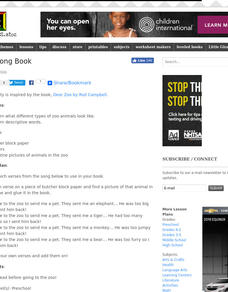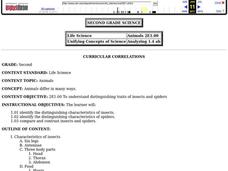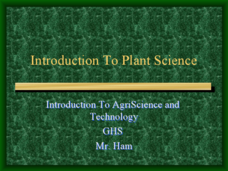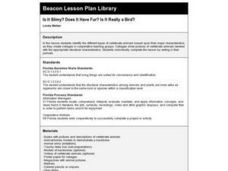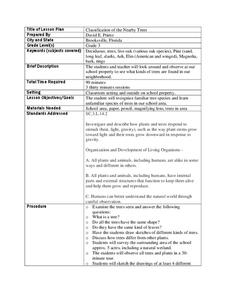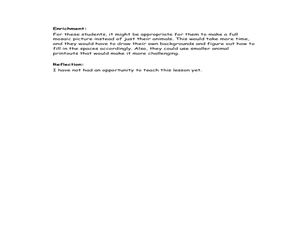Curated OER
Big Cat Classification
First graders discover the different names and classifications of big cats by using word processing applications. In this animal life lesson, 1st graders investigate one big cat and create a database of facts about it using an word...
Curated OER
Animals
Second graders explore the ways in which animals differ. They discuss the characteristics of insects and spiders. Students identify the characteristics of insects and spiders. They compare and contrast insects and spiders.
Curated OER
High Frequency and Spelling Words: 25
Using their readers, learners answer questions, compose sentences, fill in the blanks, and compare two stories. Each activity is intended to build high frequency vocabulary and spelling proficiency, and is scheduled for a different day...
Curated OER
Introduction to Plant Science
Although the formatting is less than perfect and some of the pictures are blurry, the information in this presentation on plants is pertinent. Viewers will be able to compare and contrast plants with animals. They will learn about...
Curated OER
Marine Habitats of Galveston Island
Four lessons introduce elementary ecologists to salt marsh and sandy beach habitats. In the first lesson, they place shells and other materials in vinegar to determine if they contain calcium carbonate. In the second lesson, they read a...
Curated OER
Gone But Not Forgotten
Third graders examine animals and organisms that have become extinct and their similarities to living organisms. In this extinction instructional activity students divide into groups and research extinct animals.
Curated OER
What Were Dinosaurs Like?
Students view a video clips about Dinosaurs. For this dinosaur lesson, students begin to understand the extinction of the dinosaurs by comparing them to contemporary animals. Students complete a research sheet on one dinosaur by...
Curated OER
What Were Dinosaurs Like?
Young scholars compare and contrast dinosaurs to animals that are alive today through basic research.
Curated OER
The Discovery of OXygen
Students conduct experiments to identify the different properties of oxygen. In this chemistry lesson, students examine its importance to life on Earth. They explore the historic dispute about oxygen's discovery.
Curated OER
Classifying Vertebrates
Second graders study animal characteristics and classification. For this animal characteristics and classifications lesson, 2nd graders determine how to classify vertebrates which include mammals, reptiles, amphibians, birds, and fish....
Curated OER
Is It Slimy? Does It Have Fur? Is It Really a Bird?
Sixth graders identify the different types of vertebrate animals based upon their major characteristics, as they create collages in groups. Collages show pictures of vertebrate animals labeled with the appropriate structural...
Curated OER
Sibling Relationships in the Animal World
Students research sibling relationships in the animal world. In this animal science lesson, students read the book, Sisters and Brothers: Sibling Relationships in the Animal World and discuss the sibling relationships. Students choose an...
Curated OER
You...Instead of the Onion Skin
Young scholars observe their own epithelial cells from the inside linings of their cheeks using DigiScope technology. They prepare a slide with both onion cells and epithelial cells and make an illustrated booklet for a PowerPoint...
Curated OER
We're All In This Together
Students discover what a coral reef is and the animals that live there. In this ecosystem lesson, students act out a story with ocean organisms. They answer questions that show the interdependency of the sea animals.
Curated OER
Classification of the Nearby Trees
Third graders practice using classification techniques to identify local trees. In this plant life instructional activity, 3rd graders discuss how trees differ from other plants and what characteristics are unique to trees alone....
Curated OER
Trait Variations for Survival
Young learners examine how different traits could give one organism an advantage over another. In groups, they view two different organisms in different environments. To end the lesson, they complete a Venn Diagram on the two organisms...
Curated OER
Seed Sorting 101
Students sort through numerous seeds to find similarities and differences. In this sorting and classifying lesson, students divide up different plant seeds based on their similarities and differences, while keeping record of their findings.
Curated OER
Activity Plan 3-4: Dreamy Rhymes
Learners write a story about an animal using rhyme. In this literacy lesson plan, the teacher shares different versions of "Mary Had a Little Lamb" with the class and that becomes the basis for the creation of a picture and story for...
Curated OER
Fun Activities Using Seeds
Students analyze the size, shape, and form of several different seeds. In this all about seeds lesson plan, students complete four activities involving characteristics of seeds. Students observe the seeds, record information about the...
Curated OER
What Do You Know About the Birds Around You?
Students compare and contrast various species of birds. After participating in a brief discussion of the characteristics of birds, they view birds in their natural habitat and in pictures with a focus on the similarities and differences...
Curated OER
Reading Comprehension Quiz
In this reading comprehension quiz worksheet, students read 3 different selections, then answer a set of multiple choice questions for each. Answers can be submitted and scored on line.
Curated OER
Art Lesson Synthesis
Students observe animals and complete an art project. In this interdisciplinary lesson, students define the word mosaic, create animal mosaics, and share their creations with the class. As students explain their art to the class they...
Curated OER
Dinosaurs 2: What Were Dinosaurs Like?
Students compare and contrast dinosaurs to animals that are alive today through basic research.


